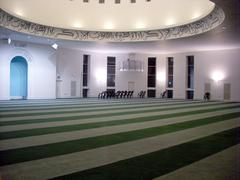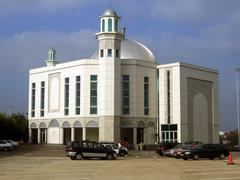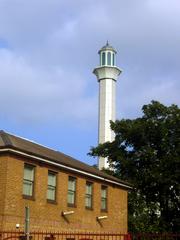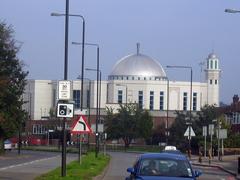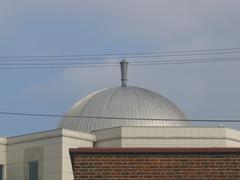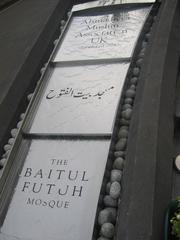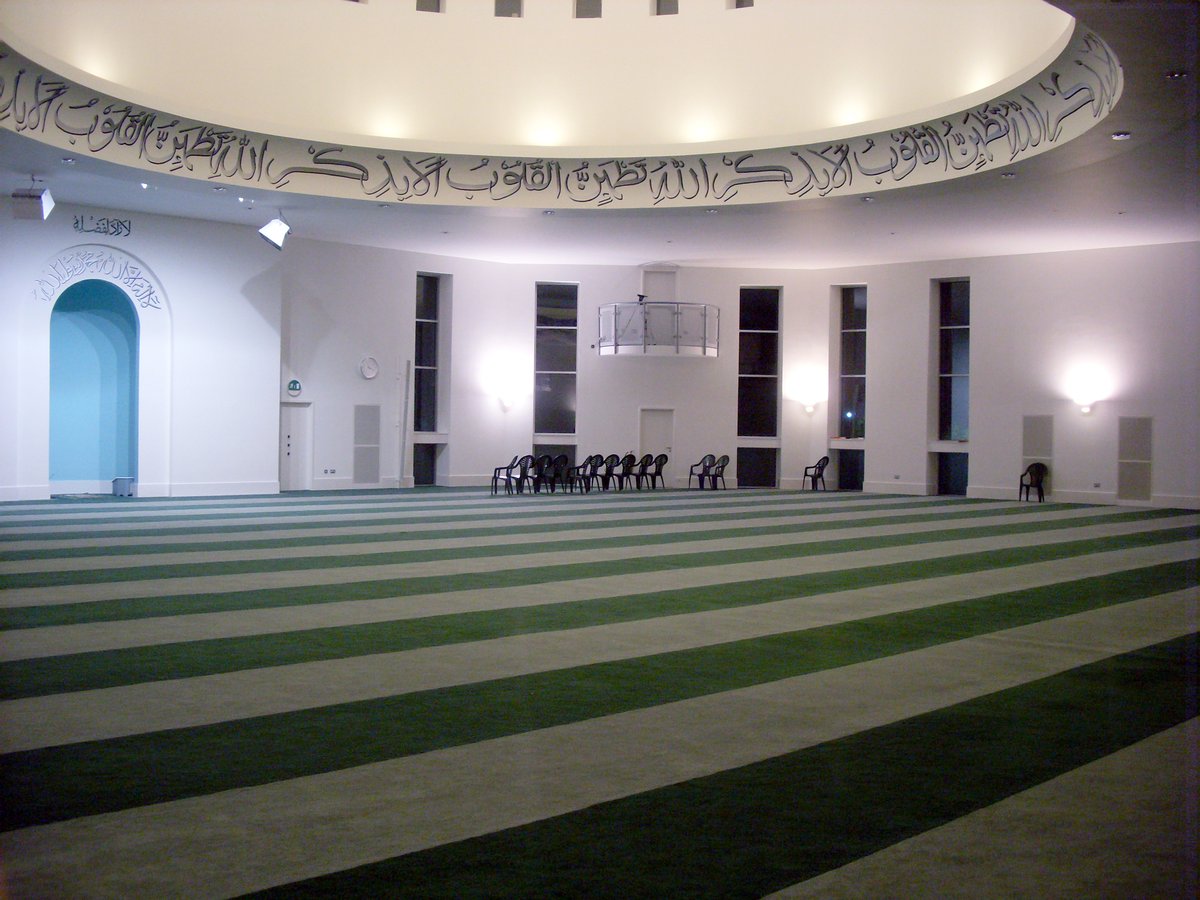
Baitul Futuh Mosque Visiting Hours, Tickets, and London Historical Sites Guide
Date: 14/06/2025
Introduction
Baitul Futuh Mosque, located in Morden, southwest London, is the largest mosque complex in the United Kingdom and a significant cultural and spiritual landmark. Officially opened in 2003 by the Ahmadiyya Muslim Community, it serves as a hub for worship, education, interfaith dialogue, and community service. The mosque’s establishment is a testament to the integration of Islamic faith and culture within London’s diverse cityscape and reflects the Ahmadiyya community’s historical journey in Britain since the early 20th century (London Museum, Baitul Futuh Official).
Architecturally, the mosque is a blend of traditional Islamic motifs and modern British design, featuring a grand white dome, the city’s tallest minaret (adapted from a dairy chimney), expansive prayer halls, community spaces, educational facilities, and advanced media studios. Baitul Futuh is designed for openness and inclusivity, welcoming visitors of all backgrounds and abilities (Wikipedia, The Plan).
This comprehensive guide provides detailed insights into the mosque’s history, architecture, visitor information, and its role within London’s religious landscape.
Table of Contents
- History and Origins
- Architectural Features
- Visiting Information
- The Ahmadiyya Muslim Community in Britain
- Community Impact and Resilience
- Baitul Futuh in London’s Mosque Landscape
- Architectural Vision and Redevelopment
- Site Layout and Design
- Sustainability and Accessibility
- Visitor Practicalities
- Frequently Asked Questions (FAQs)
- Summary and Final Tips
- References
History and Origins
Founding Vision
The need for Baitul Futuh arose from the limitations of the historic Fazl Mosque in Southfields (London’s first purpose-built mosque, 1926), which could no longer accommodate the growing congregation of the Ahmadiyya Muslim Community (Baitul Futuh Official). The community, present in the UK since 1913, sought a new space to serve as a spiritual and community hub.
Transformation of the Site
Baitul Futuh was built on a former dairy site in Morden. The transformation of this industrial space is symbolic, with the original dairy chimney ingeniously adapted into the mosque’s minaret. Construction, funded entirely by global community donations, began in the late 1990s and culminated in the mosque’s opening in 2003 (London Museum).
Architectural Features
Main Complex
- Main Prayer Hall: Accommodates up to 6,000 worshippers, with separate galleries for men and women.
- Minarets: The tallest minaret is a notable Morden landmark.
- Multipurpose Halls: Host community events, educational programs, and interfaith gatherings.
- Educational Facilities: Include classrooms and seminar rooms for religious and secular education.
- Media Studios: Home to Muslim Television Ahmadiyya International (MTA), broadcasting 24/7 content globally (Baitul Futuh Official).
Architectural Style
The mosque’s design features a harmonious blend of Islamic and modern British elements, utilizing a white dome, clean lines, spacious courtyards, and landscaped gardens that encourage community interaction (The Plan).
Visiting Information
- Visiting Hours: Generally open daily from 9:00 AM to 6:00 PM, though hours may vary during religious events. Some sources note extended hours from 8:00 AM to 8:00 PM. Always check the official website for up-to-date schedules.
- Tickets: Entry is free; no tickets required.
- Guided Tours: Offered by appointment, free of charge. Booking is recommended, especially for groups or school visits.
- Accessibility: The mosque is fully wheelchair accessible, with ramps, lifts, and accessible restrooms.
- Special Events: Open days, interfaith dialogues, and community events are held year-round—check the event calendar for details.
- Travel: Easily accessible via Morden Underground Station (Northern Line) and nearby bus routes. On-site parking is available but can be limited during peak times.
- Dress Code: Modest attire is required; headscarves are available for women. Shoes must be removed before entering prayer areas.
The Ahmadiyya Muslim Community in Britain
The Ahmadiyya Muslim Community has played a vital role in the development of Islamic institutions in the UK. The community is known for its commitment to peace, interfaith dialogue, and humanitarian service. The establishment of Baitul Futuh marks the community’s ongoing contribution to British society (London Museum).
Community Impact and Resilience
Baitul Futuh has become a center for interfaith and civic engagement, regularly hosting open days, peace symposiums, and humanitarian initiatives such as food drives and blood donation camps. After a significant fire in 2015, which damaged parts of the complex, the community quickly rallied to restore and expand the facilities—a testament to their resilience (Review of Religions).
Baitul Futuh in London’s Mosque Landscape
Baitul Futuh stands out as a purpose-built mosque, unlike many London mosques adapted from other buildings. It represents a new era of scale, inclusivity, and multifunctionality in the capital’s religious architecture (London Museum). Its design, capacity, and programming make it a benchmark for future community centers.
Architectural Vision and Redevelopment
Design and Philosophy
The original mosque, completed in 2003, was designed by Sutton Griffin and Carter Jonas, with the Ahmadiyya Muslim Association. After the 2015 fire, John McAslan + Partners led the redevelopment, adding a new administrative building and enhancing the site’s civic presence (The Plan).
Notable Features
- Dome and Minaret: The dome rises 23 meters, visible across the borough. The minaret, repurposed from the dairy chimney, is a local symbol.
- Administrative Building: Clad in limestone, with Mashrabiya screens and bronze accents, providing civic and social spaces.
- Prayer Halls: The complex can accommodate up to 13,000 worshippers during major events (Wandle News).
- Community Spaces: Include multi-function halls, library, exhibition areas, and a café (Wikipedia).
Site Layout and Design
The 5.2-acre site includes the main mosque, community halls, offices, dining rooms, and media studios. The design encourages flow, accessibility, and engagement, with an axial route leading visitors from street to prayer hall (Touristlink).
Sustainability and Accessibility
Baitul Futuh is committed to environmental responsibility. The new administrative building meets BREEAM Excellent standards and features:
- Solar panels and high-performance insulation
- Rainwater harvesting and water conservation
- Use of local materials and sustainable construction methods (The Plan)
Accessibility is prioritized with step-free entrances, lifts, and accessible restrooms. Multilingual signage and guides are available for international visitors.
Visitor Practicalities
- Dress Code: Modest clothing required; headscarves available for women.
- Photography: Permitted in designated areas. Always ask before photographing people or during prayers.
- Facilities: Gender-segregated prayer halls, library, exhibition spaces, café, and ample restrooms.
- Safety: On-site security and CCTV provide a safe environment.
- Nearby Attractions: Morden Hall Park, Wimbledon Common, and Kingston upon Thames are within easy reach.
- Tips: Visit during non-prayer hours for a quieter experience; use public transport where possible; check the mosque’s website for events and updates.
Frequently Asked Questions (FAQs)
Q: What are the Baitul Futuh Mosque visiting hours?
A: Typically 9:00 AM–6:00 PM, but sometimes 8:00 AM–8:00 PM. Check the official website for updates.
Q: Is there an entry fee?
A: No, entry and guided tours are free.
Q: Are guided tours available?
A: Yes, by appointment; booking recommended for groups.
Q: Is the mosque wheelchair accessible?
A: Yes, with ramps, lifts, and accessible facilities.
Q: Can visitors take photographs?
A: In designated areas, with permission.
Q: How do I get to Baitul Futuh Mosque?
A: Near Morden Underground Station (Northern Line); various bus routes serve the area.
Q: Is the mosque family-friendly?
A: Yes, with designated areas for children and families.
Summary and Final Tips
Baitul Futuh Mosque exemplifies faith, resilience, and community in London. As the largest mosque in the UK and one of the largest in Western Europe, it is a spiritual, educational, and cultural center open to all. The mosque’s impressive architecture, sustainable design, and humanitarian programs make it an essential destination for anyone interested in London’s history and diversity (The Plan, Wandle News, Review of Religions, London LHR).
For the latest visitor information, tour schedules, and event updates, consult the official Baitul Futuh Mosque website. Enhance your visit by using the Audiala app for personalized recommendations and up-to-date cultural insights.
References
- London Museum
- Baitul Futuh Official
- Wikipedia
- The Plan
- Touristlink
- TripXL
- Wandle News
- London LHR
- Review of Religions
- Architectural Record
- Worship AVL
- Official Baitul Futuh Mosque Website
